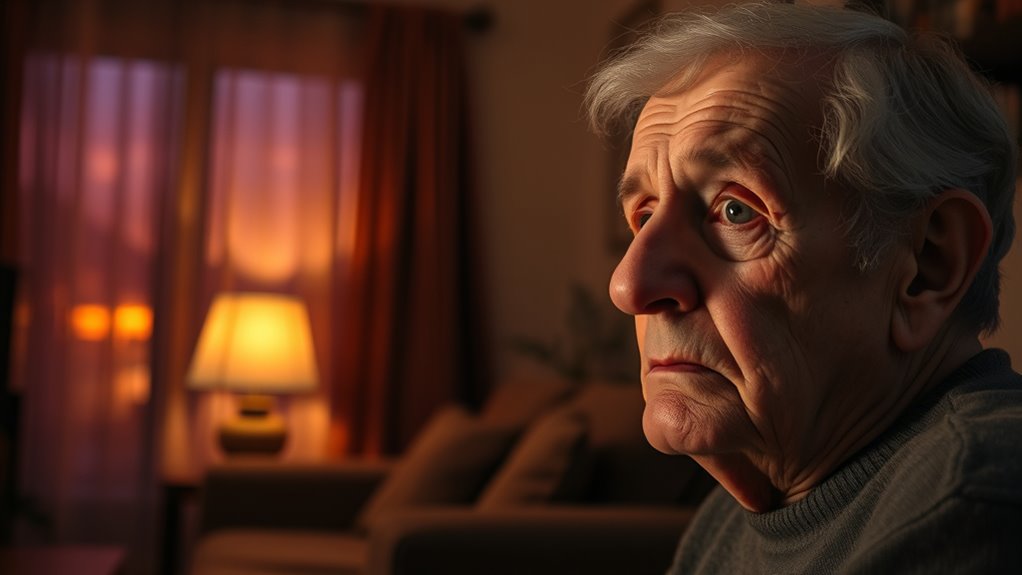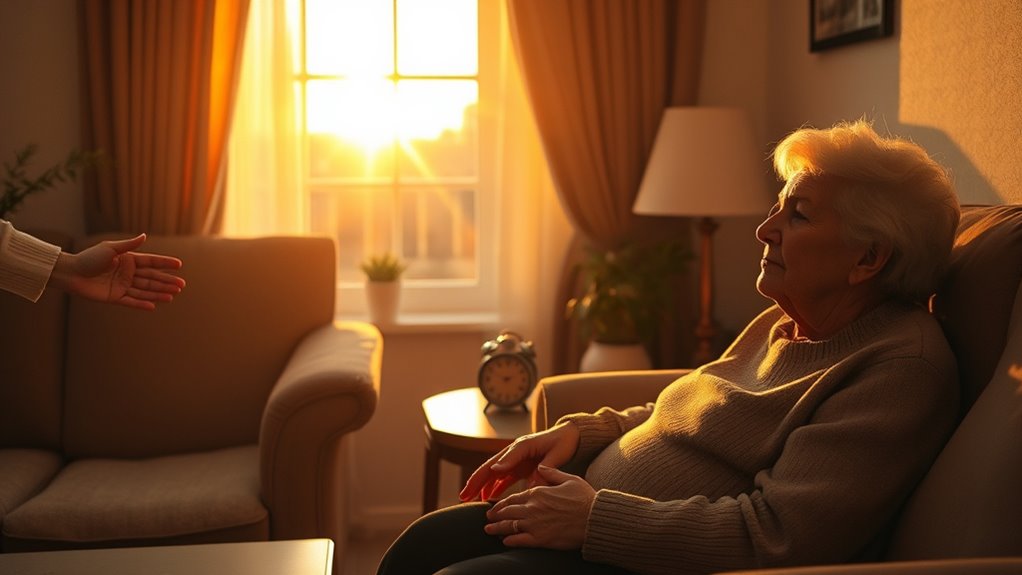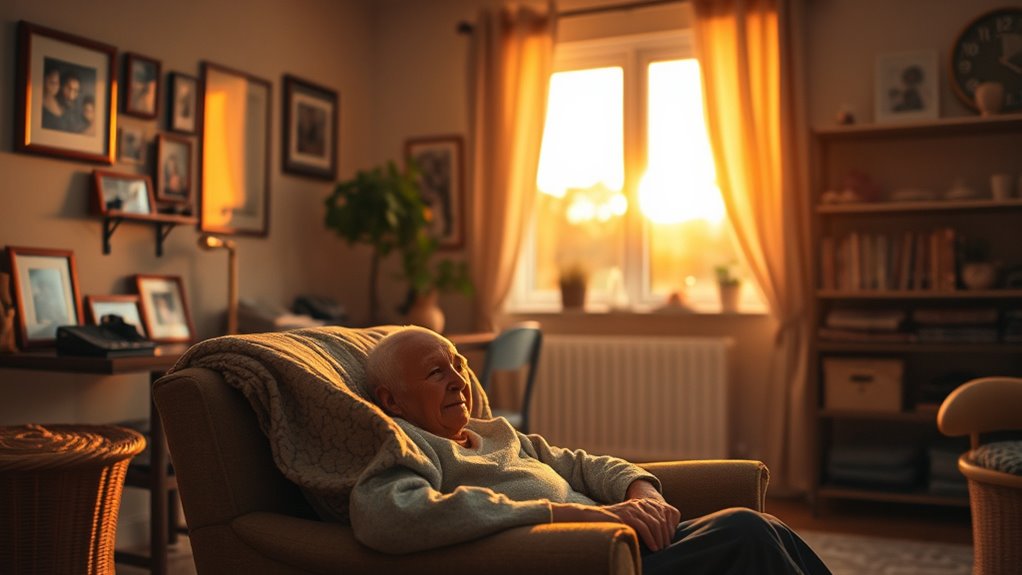Sundowning happens because brain changes from Alzheimer’s, along with disrupted sleep cycles, make you more confused and agitated in the late afternoon and evening. Environmental factors like poor lighting, noise, and overstimulation can worsen these symptoms. Fatigue, blood sugar fluctuations, and stress also play a role, making it harder for your loved one to stay calm. Understanding these causes helps you find ways to reduce their confusion—continue exploring to learn helpful strategies.
Key Takeaways
- Reduced sunlight and environmental changes disrupt circadian rhythms, leading to late-day confusion.
- Brain changes from dementia impair sensory processing and judgment, causing disorientation in the evening.
- Fluctuations in blood sugar and fatigue worsen cognitive symptoms and agitation at night.
- Sleep cycle disruptions and decreased melatonin production contribute to increased evening confusion.
- Overstimulation from noise, lights, and chaos can trigger agitation and disorientation during late hours.
What Is Sundowning and How Does It Manifest?

Have you ever noticed your loved one becoming more agitated or confused as the day winds down? That’s often a sign of sundowning. It’s a phenomenon where confusion, restlessness, and agitation increase in the late afternoon or evening. You might see them pacing, shouting, or becoming disoriented even in familiar environments. Their sleep patterns may change, leading to trouble falling asleep or waking frequently at night. Sometimes, they become more emotionally sensitive or irritable. Sundowning isn’t a sign of stubbornness or moodiness; it’s a symptom of Alzheimer’s progression. The exact cause isn’t fully understood, but it’s clear that the change in environment, fatigue, and low light can trigger these behaviors. Recognizing these signs helps you better manage and support your loved one.
The Role of Brain Changes in Late-Day Confusion

As Alzheimer’s progresses, changes in the brain disrupt the neural circuits responsible for memory, judgment, and sensory processing, which play an essential role in how your loved one perceives and reacts to their environment. These brain alterations affect their ability to interpret signals, leading to confusion and agitation, especially later in the day. The hippocampus shrinks, impacting memory, while the cerebral cortex’s deterioration hampers decision-making. This imbalance makes it harder for your loved one to process sensory input, resulting in late-day disorientation. Additionally, reduced activity in the brain’s alertness systems contributes to increased confusion during these times. The decline in neural connectivity further exacerbates difficulties in integrating sensory information and responding appropriately. Moreover, fluctuations in neurotransmitter levels can influence mood and alertness, intensifying sundowning symptoms. Here’s a quick overview:
| Brain Area | Function Affected |
|---|---|
| Hippocampus | Memory formation and recall |
| Cerebral Cortex | Judgment and sensory processing |
| Amygdala | Emotional regulation |
| Brainstem | Alertness and arousal |
Disruptions in the Sleep-Wake Cycle and Their Impact

The brain changes associated with Alzheimer’s not only impair memory and judgment but also markedly disrupt the sleep-wake cycle. You might find yourself awake during the night and confused during the day, as the internal clock loses its regular rhythm. This disruption leads to fragmented sleep, making you feel tired and less alert. When sleep cycles are off, your brain doesn’t get enough restorative rest, which worsens cognitive issues and mood. The lack of proper sleep also affects the production of melatonin, a hormone crucial for regulating sleep. As a result, your body struggles to maintain a steady pattern of wakefulness and rest, which can intensify late-day confusion and agitation. Understanding this cycle helps you recognize why sundowning occurs and how sleep problems contribute to it. Additionally, eye patch benefits such as improving hydration and reducing puffiness can help promote a more restful sleep by soothing tired eyes and reducing discomfort. Recognizing how disrupted sleep regulation affects brain function can also guide effective management strategies to improve quality of life.
Environmental Triggers That May Exacerbate Sundowning

Environmental factors can considerably worsen sundowning symptoms in individuals with Alzheimer’s. Bright lights, especially flickering or harsh lighting, can increase agitation and confusion. Noise levels also play a significant role; loud or sudden sounds may trigger distress or disorientation. Cluttered, chaotic spaces create confusion and make it harder for your loved one to focus or feel safe. Poorly ventilated or uncomfortable environments can heighten restlessness. Additionally, changes in the environment, such as rearranged furniture or unfamiliar surroundings, may intensify feelings of insecurity. Managing lighting, reducing noise, maintaining a tidy space, and ensuring a comfortable setting can help lessen these triggers. Creating a calm, familiar environment supports your loved one’s ability to stay grounded during the late hours. Incorporating preppy dog names or other well-chosen names into the environment can also provide comfort and familiarity. Paying attention to the sleep impact and fostering a peaceful atmosphere can further reduce agitation and enhance overall well-being.
Common Behaviors Associated With Sundowning

Sundowning often brings about a range of challenging behaviors that can be distressing for both your loved one and you. Common signs include increased agitation, restlessness, and irritability, which may appear suddenly and persist into the evening. Your loved one might become confused or disoriented, asking repetitive questions or wandering aimlessly. Some individuals exhibit pacing or pacing-related behaviors, such as fidgeting or pacing in circles. You may also notice mood swings, with episodes of frustration or anger. Sleep disturbances are frequent, with difficulty falling asleep or waking frequently during the night. These behaviors can escalate without warning, making it hard to provide comfort and support. Recognizing these common behaviors helps you respond more effectively and maintain a calmer environment. Understanding behavioral patterns can also facilitate better management strategies during sundowning episodes. Incorporating AI-driven insights can help anticipate and address these behaviors more proactively, improving care. Awareness of Alzheimer’s disease progression can further inform your response to these behaviors and tailor interventions effectively. Additionally, understanding mental wellbeing factors can help caregivers develop more compassionate and effective support strategies during challenging episodes. Being aware of the underlying causes of behavioral changes can aid in addressing the root issues behind sundowning behaviors.
The Influence of Fatigue and Hunger on Symptoms

When fatigue or hunger hit, your loved one’s energy levels can plummet, making symptoms worse. Fluctuations in blood sugar can also increase confusion and agitation. Recognizing these signs helps you manage symptoms more effectively and provide the support they need.
Energy Levels Drop
As fatigue and hunger set in, your loved one’s energy levels often decline sharply, intensifying sundowning symptoms. When they feel tired or hungry, it becomes harder for them to stay calm and focused. Low energy can lead to increased agitation, confusion, and restlessness. They might become more easily frustrated or overwhelmed by their surroundings. As their stamina diminishes, they may struggle to communicate or follow directions. This drop in energy also makes it difficult for them to manage emotions or cope with changes in routine. Recognizing these signs early helps you provide support, such as offering a quiet space or a small snack, to help stabilize their energy levels and reduce the severity of sundowning behaviors.
Blood Sugar Fluctuations
Fatigue and hunger not only drain your loved one’s energy but also cause fluctuations in blood sugar levels, which can worsen sundowning symptoms. When blood sugar drops, it can lead to confusion, irritability, and restlessness, intensifying late-day agitation. To help stabilize their mood, guarantee they eat regular, balanced meals with complex carbs, protein, and healthy fats. Avoid long gaps between meals, as sharp drops in blood sugar can trigger symptoms.
| Hunger Level | Blood Sugar Effect | Resulting Behavior |
|---|---|---|
| Low | Drops sharply | Increased confusion |
| Stable | Maintains steady | Calm, less agitation |
| High | Spikes quickly | Restlessness, irritability |
Monitoring their eating habits can considerably reduce sundowning episodes.
Physical and Mental Fatigue
Physical and mental fatigue considerably impact your loved one’s ability to stay calm and alert during the evening hours. When they’re tired, their brain struggles to process information clearly, making confusion and agitation more likely. Fatigue lowers their resilience to stress, so minor frustrations can escalate quickly. Hunger also plays a role, as low energy from skipping meals or not eating enough worsens fatigue. Ensuring your loved one gets adequate rest and regular, balanced meals helps stabilize their mood and reduce sundowning symptoms. Recognizing these signs early allows you to adjust routines, provide quiet time, and prevent overstimulation. By managing fatigue and hunger, you can help your loved one experience calmer evenings and lessen the intensity of late-day confusion.
How Stress and Overstimulation Contribute to Confusion

Stress and overstimulation can considerably increase confusion during sundowning episodes. When your loved one feels overwhelmed by noise, bright lights, or too many activities, their brain struggles to process information clearly. This overload makes it harder for them to distinguish between reality and confusion, intensifying feelings of disorientation. Elevated stress levels also trigger the release of hormones that can impair cognitive function, further worsening their confusion. As their environment becomes too stimulating, they may become agitated or anxious, which can escalate their disorientation. Keeping settings calm and minimizing unnecessary stimuli helps reduce this overload. Recognizing when stress and overstimulation occur allows you to intervene early, helping your loved one feel safer and more at ease during these challenging times. Being aware of seed allergies is important to avoid additional health risks that could compound their confusion. Additionally, understanding how hydrotherapy can promote relaxation might be beneficial in managing stress levels. Incorporating calming environments with comfortable seating can also help soothe agitation and reduce overstimulation, especially when combined with calming music and other sensory interventions.
Strategies to Minimize and Manage Sundowning Episodes

Implementing practical strategies can markedly reduce the intensity and frequency of sundowning episodes. First, keep the environment calm and well-lit to reduce shadows and confusion. Establish a consistent daily routine to provide predictability. Encourage physical activity during the day to promote better sleep and reduce agitation. Limit caffeine and sugar intake, especially in the late afternoon. Use familiar objects and photos to comfort and orient your loved one. Creating a digital-friendly environment at home can also support cognitive engagement and reduce confusion during evening hours. Incorporating payment solutions that are simple and accessible may also help caregivers manage daily tasks more efficiently, reducing stress during challenging times. Additionally, fostering a relationship based on trust and understanding can help your loved one feel more secure during these episodes. Maintaining environmental stability is also crucial in minimizing sensory overload and reducing sundowning symptoms. Establishing a consistent lighting schedule can further help regulate your loved one’s internal clock and reduce sundowning behavior.
The Importance of Routine and Environment in Care Settings

Creating a consistent routine and a carefully designed environment is essential in care settings to minimize sundowning symptoms. When you establish predictable daily activities, your loved one knows what to expect, reducing anxiety and confusion that can trigger late-day agitation. Keep routines simple, regular, and calming, especially in the late afternoon and evening. Environment-wise, guarantee the space is well-lit but not overly bright, minimizing shadows that can cause disorientation. Reduce noise levels and eliminate clutter to create a peaceful atmosphere. Comfortable, familiar surroundings help your loved one feel secure and less overwhelmed. By intentionally shaping routines and environments, you help prevent the triggers that often worsen sundowning, promoting a sense of stability and calm as the day winds down.
Supporting Loved Ones During Late-Day Challenges

As the day comes to a close, your loved one may become increasingly restless or confused, making late afternoons and evenings particularly challenging. To support them, try these strategies:
- Maintain a calm environment by reducing noise and bright lights, which can overstimulate.
- Offer reassurance through gentle communication, eye contact, and comforting touches to ease anxiety.
- Engage in simple activities like listening to soothing music or looking through photos to provide familiarity and distraction.
Stick to a routine as much as possible, and avoid arguing or correcting them. Staying patient and present helps reduce their stress. Remember, your calm presence can considerably ease their confusion and agitation during these difficult hours.
Frequently Asked Questions
Can Sundowning Occur in Other Types of Dementia Besides Alzheimer’s?
Yes, sundowning can occur in other types of dementia besides Alzheimer’s. You might notice late-day confusion, agitation, or restlessness in individuals with Lewy body dementia, vascular dementia, or frontotemporal dementia. The same factors that cause sundowning in Alzheimer’s—such as changes in light, fatigue, or disrupted routines—can trigger similar behaviors. Recognizing this helps you provide better support and create a calming environment during those challenging hours.
Are There Medications Specifically Approved for Managing Sundowning Symptoms?
You’re wondering if there are medications approved to manage sundowning. While no drugs are specifically labeled for sundowning itself, doctors often prescribe medications like antipsychotics, antidepressants, or sleep aids to help. These can ease symptoms, but they’re not a one-size-fits-all fix. Always consult a healthcare professional to determine the safest and most effective approach for your loved one’s unique needs.
How Does Weather or Seasonal Change Affect Sundowning Behavior?
You might notice that weather or seasonal changes impact sundowning behavior, as reduced sunlight can interfere with your loved one’s internal clock. Shorter days and cloudy weather often lead to increased confusion, agitation, or restlessness in Alzheimer’s patients. To help, guarantee they get plenty of natural light during the day, keep a consistent routine, and create a calming environment. These steps can ease their symptoms during seasonal shifts.
Can Physical Exercise Reduce Late-Day Confusion in Alzheimer’S Patients?
You might be surprised to learn that regular physical activity can reduce late-day confusion in Alzheimer’s patients by up to 30%. Exercise helps regulate sleep patterns, reduces anxiety, and boosts overall mood. When you encourage your loved one to stay active, especially earlier in the day, it can improve their mental clarity later on. Consistent exercise routines create a calming effect, helping to minimize the episodes of confusion that often occur in the evening.
What Are Emerging Therapies or Research Developments for Sundowning Management?
You should know that emerging therapies for sundowning focus on non-pharmacological approaches like personalized light therapy, which helps regulate circadian rhythms, and cognitive behavioral techniques to reduce agitation. Researchers are also exploring the use of wearable devices to monitor sleep patterns and environmental modifications to create calming spaces. These developments aim to improve quality of life by addressing the root causes of late-day confusion, offering hope for better management strategies in the future.
Conclusion
Understanding sundowning shows you the complexity behind late-day confusion, where the brain’s changes clash with stress and environment. While you can’t eliminate every trigger, creating calm routines and familiar surroundings offers stability amid chaos. It’s a delicate balance—like holding onto a fragile flame in the dusk—guiding your loved one through the twilight hours with patience and compassion. Ultimately, your support turns confusion into comfort, lighting the way through the evening’s shadows.









